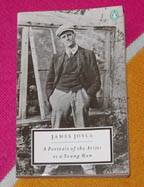 This amateur guide to James Joyce is intended to do two things: First, to introduce this modernist literary master to the philistines who have either never read or never heard of him and second, to delineate the books according to level of Joyce enthusiast you aspire to be. In other words, instead of doing these four books piecemeal, I’ve decided to lump them all together into four levels of increasing pain and frustration.
This amateur guide to James Joyce is intended to do two things: First, to introduce this modernist literary master to the philistines who have either never read or never heard of him and second, to delineate the books according to level of Joyce enthusiast you aspire to be. In other words, instead of doing these four books piecemeal, I’ve decided to lump them all together into four levels of increasing pain and frustration.
Part Three – The Advanced: Periodic loss of vision, migraine or stroke.
First serialized in 1914, Joyce’s novel A Portrait of the Artist as a Young Man was finally published in its entirety in 1916. Compared to the rest of his work, Portrait comes in second for comprehensibility and acts as a suspension bridge between the relative lucidity of Dubliners and the schizophrenia of Ulysses. Semi-autobiographical, Portrait introduces Stephen Dedalus, one of the protagonists from Ulysses and Joyce’s fictional self. It begins with Stephen’s childhood thoughts, written with the vocabulary of a four-year-old.
In the next section, Stephen is a nine or ten-year-old student at Conglowes Wood College. His language is a bit more sophisticated, but the narrative pinballs for a 2x bonus among the typical range of interests for that age: His schoolwork, teachers, friends and going home for holiday. There is no plot, just character development. Portrait is a prime example of the Künstlerroman, a novel exploring the emotional and idealistic development of an artist. Other examples include Thomas Wolfe’s Look Homeward, Angel, Knut Hamsun’s Hunger, and W. Somerset Maugham’s Of Human Bondage. In each section of Portrait, Stephen Dedalus grows into a man and puts away childish things.
He recognizes his father is but mortal. Once a knowledgeable, well-to-do magistrate, Stephen’s father suffers a reversal of fortune due to several ill-advised financial decisions. Young Stephen has to leave Conglowes, but soon finds himself a student at Belvedere College in Dublin, which specializes in preparing boys for the priesthood. There, he distinguishes himself by writing essays and poetry.
There is a marked difference in Joyce’s descriptive style when Stephen decides to forego the priesthood to attend university and become a writer. The young man goes on about the “prism of a language many-coloured and richly storied,” and suddenly the ordinary things he sees are sunrise gold, azure, russet, corpse white, and emerald as if the eyes of a dead man were opened to observe the world of the living. Perhaps they were. As a priest-in-training, he was more interested in assuring his place in the afterlife than making a mark on the current one.
The underlying historical context of A Portrait of the Artist as a Young Man is Ireland’s struggle to wrest control of its destiny from England. The four-year-old Stephen hears of Michael Davitt and Charles Parnell, two men instrumental in furthering Ireland’s cause. While at Conglowes, he learns of Parnell’s death. He senses the sorrow of the Jesuit teachers and the gravity of the event, but a personal sense of grief escapes him.
As Ireland seeks a national identity and Home Rule, Stephen struggles to form an identity of his own at University College. He and his friends lapse into Latin frequently to deliver the punch lines of jokes or insult each other. There’s a line about ellipsoidal balls and the cavalry that would have been funnier if it hadn’t sailed over my head. Stephen seems to quote St. Thomas Aquinas in every other sentence while Aristotle, Rousseau, and Darwin receive honorable mentions.
In reality, the writings of Aquinas did leave a lasting impression on Joyce and greatly influenced his sense of ethics and aesthetics. His childhood upbringing closely mirrors that of Stephen’s, as does his schooling, choice of vocation, skepticism and mistrust of the Catholic faith and final expatriation from Ireland.
1914 was a banner year for Joyce. He published Dubliners and scraped Portrait off his desk and into print, effectively clearing the way for intensive work on his next project, Ulysses. Portrait helps to pave the way somewhat for its lauded psychosis. Those in the Advanced Joycean category will appreciate the precursor and semi-autobiographical insight into James Joyce the man.








